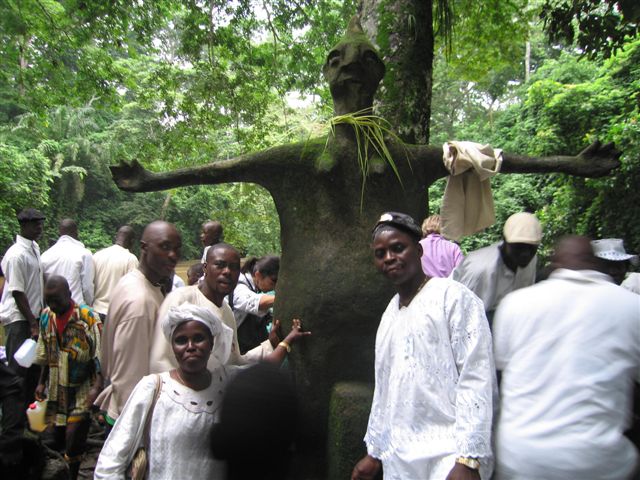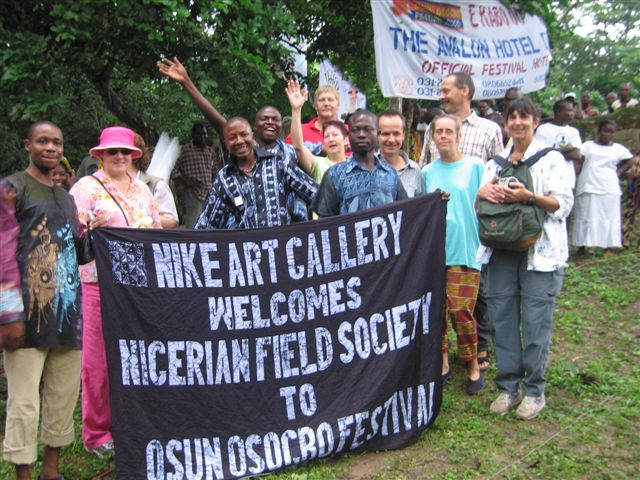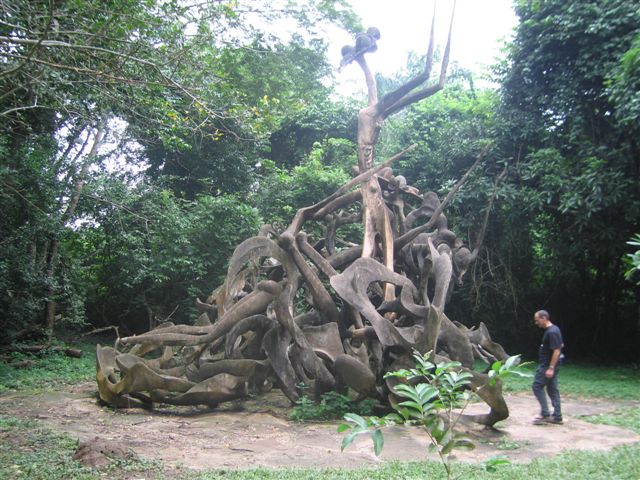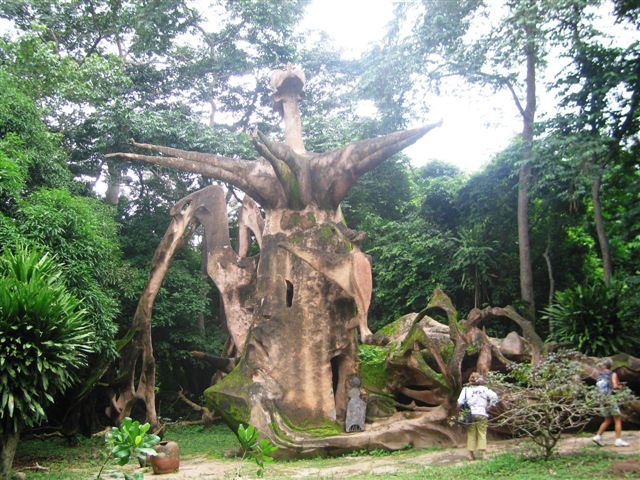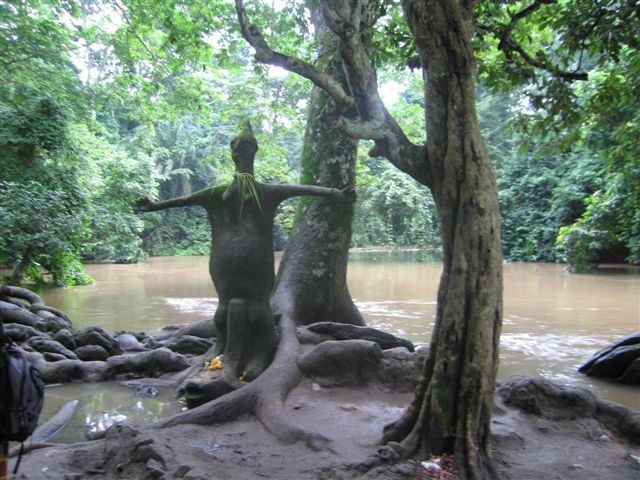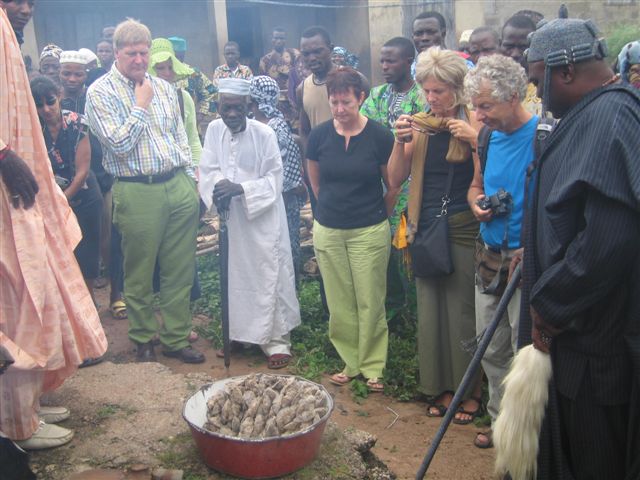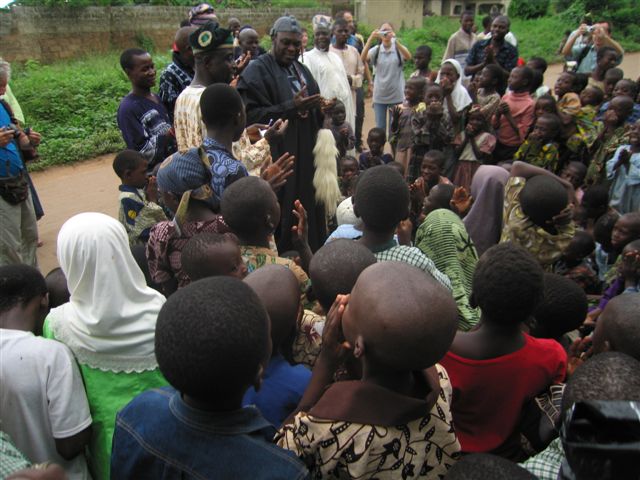Trip to: Osogbo Festival
Date 3-6 August 2006
Trip report: Lindie Rudover and Gerold Beck
The meaning of Osogbo in Yoruba is witches and wizards in the forest. This description was definitely an accurate prelude to the mystics of the Osun – Osogbo festival adventure for the 12 Field Society members (which included two royal chieftains – read on for details). Osogbo is a very vibrant community, rich in arts, culture and spiritual activities. We had the opportunity to learn how to make the indigo material and to hear ‘the behind the scene stories’ that inspired the creation of some of the intricate woodcarvings.
Nike, (from Nike Cente for Art & Culture), who is a creative artist in her own rite, is a very strong advocate for the local artists. She arranged personal guides to ensure that all our artistic interests were met. Accommodations at Nike’s guesthouse included delicious meals (even though some dishes were too spicy-hot for some palates) and an evening of local entertainment.
The Osun Festival
The ancestors of the Yoruba people of Osogbo came from Ipole-Omu in search for the holy waters. When the oracle guided them to the Osun River and revealed Osogbo as their new home grounds, they promised to celebrate the occasion and to renew their gratitude to Osun every year. Prosperity and protection will be granted as long as this vow is kept. The last day of the Osun festival keeps this spirit alive to the present days and the future.
Friday, August 4, 2006, was the last day of the 12-day long celebration-taking place in Osogbo. Early in the morning, people from all over the country, gather in the city and make their way down to the Sacred Groves, the various shrines and, most important, to the holy waters of the Osun River. Dressed in their best clothing they proceed to the river to take their moment of peace, cleanse themselves with the sacred water and pray for forgiveness and for the help from Osun, the goddess of fertility, prosperity and protection. The offerings (food, fruits, money) are bestowed to the sacred waters. Bottles and jugs are filled with the water from the river in order to bring the spirit of Osun back home to the families.
Hundreds, if not thousands, of people gather outside the old and 1st place of Osun to await the procession of chiefs, the Ataoja (king) of Osogbo Land and the climax of it all, the arrival of Arugba, the virgin of the royal maidens carrying the calabash with the sacred offerings to Osun. When Arugba enters the inner circle, the drums are playing a frantic beat and the people are waving their hands backwards over their heads (symbolic for: let all the bad I did pass; let no bad things fall onto me). While the Arugba prays with the high priests in the shrine, the singing and dancing continues. Finally, the contents of the calabash, the sacred offerings, are handed over to the waters and the vow has been renewed for another year.
Note to the wise: if you are planning to attend the festival, be prepared for the unexpected, the thousands of spectators and the intensity of hordes of people that are passionately involved in the entire ritual.
Sacred Groves
The area of the Sacred Groves of Osogbo has different meanings to the many visitors of this mysterious site. For the Yoruba people, the high shrine at the holy Osun River is the first place of worship. The goddess Osun, upper part female and lower part fish, is the mysterious mermaid goddess standing for fertility, prosperity and well-being. For the high priests and the Osun of Osogbo, these groves are the meeting place and place of worship. Certain areas of this magnificent forest is home for a wide variety of mammals, birds, reptiles and insects and a large variety trees and unique specimen of flora.
Most significant for the visitors interested in art and history are the unique and mysterious sculptures by the Austrian artist Susanne Wenger. Set at sacred selected locations in the forest, these structures of metal suspensions covered by cement and plaster symbolize the divinities of the Yoruba religion, the vicious circle of life and the unity of physical and spiritual destiny. Susanne Wenger came to Nigeria as a young European artist, married the “drummer man” and became part of the Yoruba people and lived and worked for the conservation, protection and development of the Sacred Groves of Osogbo. The complex physical structure, the spiritual significance and the metaphorical symbolism cannot be described in words. When we asked Susanne Wenger, now 91 years old, if she could tell us more about the Sacred Groves of Osogbo, she said: “No, you have to go there and FEEL IT yourself”……and we did…..
Honorary chieftains
The 37th King – Oba Adeen, Oludo of Ido-Osun granted the Nigerian Field Society a private audience, which consisted of speeches, a local dancer, talking drummers and a bugle player (with an exceptional lung capacity). The king, after graciously accepting our gifts, invited us into his inner chambers to discuss our future involvement with the development of his community – ‘co-operate to operate’ (espoused by the Oba).
In honour of our visit, the king led a procession around his palace, through his village and took this opportunity to explain the co-op production of soap making. It was amazing to witness an entire community worship the ground that the Oba walked on, and beseech him for a single look or word as a special blessing.
To end a wonderful weekend, the NFS was offered free property in the Ido-Osun area to develop local enterprise and Robin and Hugh Campbell were offered the opportunity to be made chieftains of the kingdom. This is a royal honour well deserved, in light of all the work that Robin and Hugh do for the NFS, as well as the excellent planning of a memorable Osogbo weekend.
